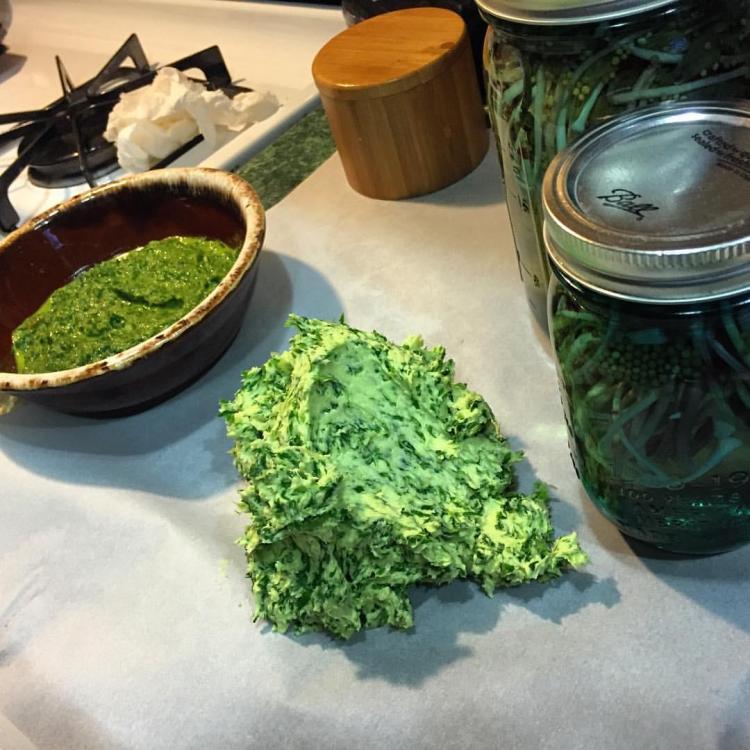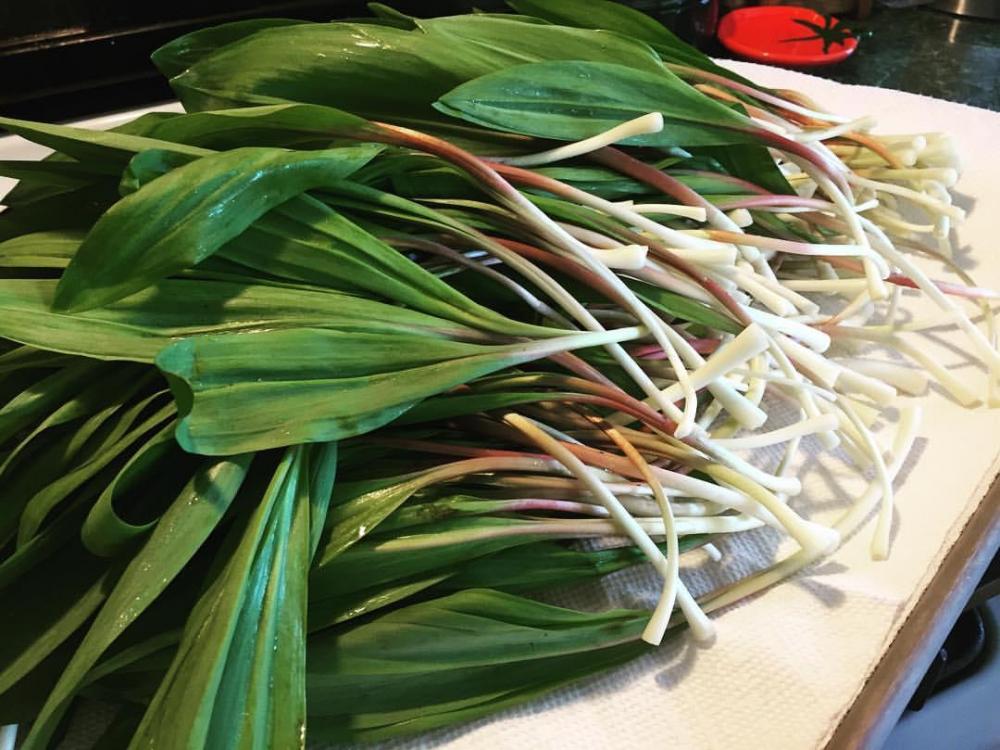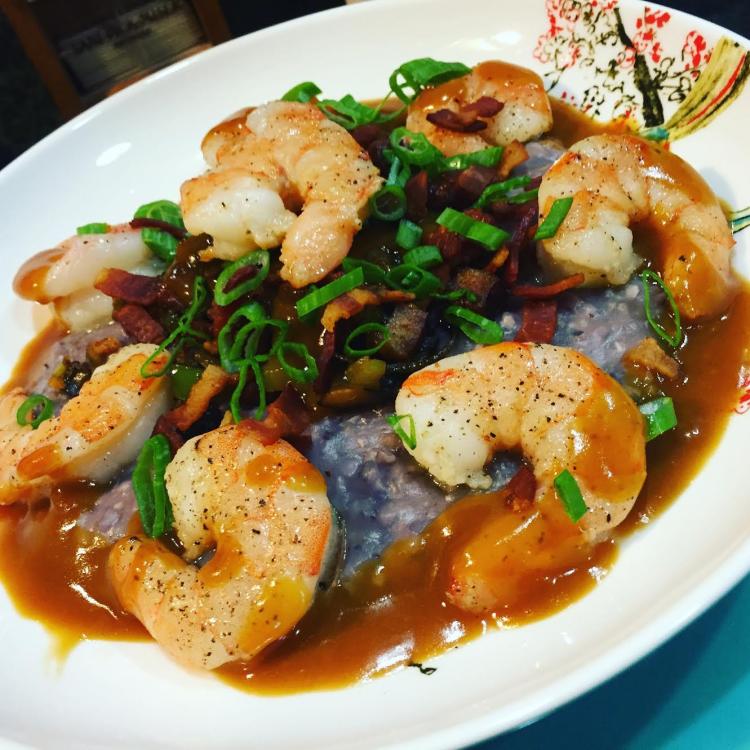-
Posts
1,807 -
Joined
-
Last visited
Content Type
Profiles
Forums
Store
Help Articles
Everything posted by btbyrd
-
You have to salt the bajeezus out of A5 Wagyu, so I imagine that there's a continuum.
-
They're not on eGullet, but Doug Baldwin's SV resources are great, as is everything at ChefSteps.com.
-
I almost always include a huge amount of diced onion in mine and almost always sautee it briefly. If you cook it too long, it turns to mush. It's also important not to process the cauliflower too early or to cook it too far ahead of time, or else you might have a stinkbomb on your hands. It doesn't always happen, but it's sad when it does. Variations include: Dirty rice (saute some cubes of andouille sausage, cook the cauliflower in the fat, add paprika and cayenne, garnish with green onions) Fried rice (char siu, ginger, garlic, carrot sticks, peas, garnish with green onions) "Chipotle style" (chopped cilantro plus lime juice) Indian style (curry or masala powder) "Cheese Grits" (lots of butter and melty cheese)
-
I couldn't imagine ever cooking raw meat that set out overnight, let alone consuming it after noticing that it reeked of ammonia . You dodged a bullet, my friend.
-
An article on this subject by Jeffrey Steingarten. And an episode of The Sporkful in which the host consumes too many edibles with Radiolab's Jad Abumrad.
-
Thanks! I just blanched them and put them in a salad spinner to get rid of all the excess surface water. I haven't had any issues with it (yet). I literally LOL'd at that one. Nice!
-
This is the first year I've been able to get them. These were purchased for too much money at a grocery store, but I found a big patch out in the woods that I'm going to harvest from sometime later this week. Even though they were from a grocer, they were still covered in boatloads of dirt and mud at the roots. Took me forever to clean them, but here they are: On a quest to make it last, I pickled some, made ramp butter, and made a ramp chimichurri for dinner that night. Dinner that night: "Sprung!" Lamb with ramp chimichurri and sauteed morels, baby carrots (the purple ones were glazed with balsamic), asparagus, and a 63C yolk.
- 178 replies
-
- 12
-

-
In many cases, steaming actually takes more time to cook food to a target temperature than boiling does.
-

Polyscience Sous Vide Toolbox (formerly known as SousVide Dash)
btbyrd replied to a topic in Cookbooks & References
It's now called the Polyscience Sous Vide Toolbox. Host's note: the topic title has been edited to show both the original and the new name in order to assist with future searches, with thanks to btbyrd for the update. -
Spring is here: Slagel Family Farm lamb loin chops with ramp chimichurri over sautéed morel mushrooms; baby white and purple (balsamic glazed) carrots; asparagus with 63C egg yolk and Maldon salt.
- 485 replies
-
- 13
-

-
I like the idea of this, but it seems bulky for storage (and my freezer is tight as it is). I'm going to roll my own by freezing water in vacuum bags and seeing how that works out.
-
Shrimp and grits. Proliferation of superfluous adjectives:Anson Mills organic, field ripened, sweet native heirloom blue corn grits; wild caught tiger shrimp confit sous vide in bacon fat; Father's country bacon lardon; D'Artagnan pasture raised, heritage pork andouille sausage sautéed with the cajun trinity and mushrooms; spicy shrimp gravy.
- 485 replies
-
- 13
-

-
Thanks for sharing this! It plays fine for me using VPN with AdBlock disabled. While searching for more information on this show, I came across Heston's Dinner In Space which also aired recently:
-
I haven't tried the recipe, so I can't say... but it looks to be pretty good! I've been relying on the ChefSteps and Modernist Cuisine batter recipes as of late. My favorite is the ChefSteps recipe for batter that's aerated in a whipping siphon. It's light and lacy and doesn't require the addition of beer or vodka. I don't drink vodka and don't buy the sort of beer you'd typically use in a batter, so that recipe has been a blessing. Let us know how the Serious Eats recipe works out!
-
Ah, I misunderstood your timeline! Sorry that the lemon/water soak didn't take care of the issue for you. It's a shame to have to throw things out, but sometimes that's all you can do. Hope things work better for the sole!
-
They make good products. One of my favorites is their porcini mushroom powder which is an excellent addition to soups, stews, and risotto (and as part of a rub for grilled meats). The particle size on that powder is better than I can get from buying mushrooms and blending them myself. Their spray-dried cheese powders are also good and are great for topping for popcorn or homemade potato chips. I haven't used the dehydrated butter, but I imagine it'd be good for that purpose too. I've also purchased whole spices from them and have been pleased with the quality/price ratio. Most, if not all, of their products are available on Amazon, where you can check out reviews. Give them a try!
-
It's easier to avoid clumping if you start by dry-blending cornstarch with flour, as the flour gets between the starch particles and helps them stay separate. You'll also have a different texture in the final fried batter. Corn starch absorbs more oil than what flour does, so the final product may be greasier than it otherwise would be.
-
I never buy fish that I don't cook or process the same day. Letting it hang out in your fridge for several days and relying on sniff tests isn't conducive to either safety or deliciousness.
-
I use Epicurean cutting boards which are made of wood fiber compressed with resin. They're durable, kind to your knives, and can go in the dishwasher. All the benefits of plastic without being plastic. I hate plastic.
-

Chris Kimball is leaving America's Test Kitchen - contract dispute
btbyrd replied to a topic in Food Media & Arts
I just hope that with Chris gone, they'll stop saying that they have the recipe for "The Very Best _________". -
Air fryers are lies.
-
Glad you made it! Isn't it nice that ramen broth freezes so well? Chang and Momofuku actually have (at least) 2 ramen recipes floating around. The classic one printed in the cookbook is pork based and begins with Benton's bacon dashi. Their newer, "2.0 Recipe" is primarily chicken based and doesn't start with bacon dashi. Rather, it adds Benton's bacon fat at the end (and uses it in the tare). It also calls for grinding the shiitakes into a powder instead of soaking them and using them whole, as in the "1.0" recipe.
-
A wheat noodle that has been treated with an alkaline salt such as kansui. If you can't find kansui, Harold McGee discovered that if you cook baking soda in the oven for an hour, it becomes much more alkaline and can be used as a substitute for kansui. This is the basis of, for example, the noodle recipe in David Chang's Momofuku cookbook. But even Momo don't make their own; they get it from Sun Noodle. I also think that the pre-fried instant nramen oodles are perfectly acceptable substitutes. By and large, however, their seasoning packets are terrible. (There are notable exceptions, however.) There's no shame in using them with quality broth and high quality toppings.
-
I didn't know that. In English language markets -- at least the ones I've been in -- I've never seen what I considered to be real dried ramen. I've seen some that weren't alkaline noodles as well as some gluten free rice flour "ramen" which I don't consider ramen either. Good to know that there's a real product out there.





